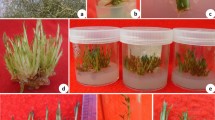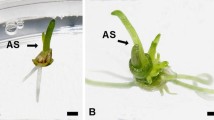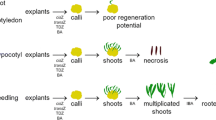Summary
The effects of thidiazuron, benzyladenine and zeatin were tested with respect to bud regeneration of different flax explants from hypocotyls, cotyledons and apices of two fibre varieties (Ariane, Viking) and one linseed variety (Antarès). These three cytokinins were tested either alone or in combination with naphthalene acetic acid, indole acetic acid or 2,4-dichlorophenoxyacetic acid.
Hypocotyls were the most responsive explants. Thidiazuron was significantly the most effective followed by benzyladenine, and then zeatin, in inducing organogenesis from hypocotyl segments. The optimal thidiazuron concentration for bud regeneration from hypocotyls was 0.1–0.3 μM in combination with 0.01 μM of naphthalene acetic acid. Six days after plating, shoot initials began to appear on hypocotyl sections compared with ten to fifteen days when using benzyladenine or zeatin.
Similar content being viewed by others
References
Basiran N, Armitage P, Scott J, Draper J (1987) Plant Cell Rep. 6:396–399
Chevreau E, Dufour M, Duron M (1988) In: Les Sratégies De Selection Face aux Technologies Modernes Moet Hennessy Conference (p22), Paris
Dong JZ, McHughen A (1993) Plant Cell Rep. 88:61–71
Fasolo F, Zimmerman RH, Fordham I (1989) Plant Cell Tissue Organ Cult. 16:75–87
Gamborg OL, Shyluk JP (1976) Bot. Gaz. 137:301–306
Heller R (1953) Ann. Sci. nat., Bot. Biol. veg. Paris 14:1–223
Hepburn AG, Clarcke LE, Blundy KS, White J (1983) J. mol. appl. Genet. 2:211–224
Jordan MC, McHughen A (1988) Plant Cell Rep. 7:281–284
Kerns HR, Meyer MM (1986) Hortscience 21:1209–1210
Lane D (1979) Physiol. Plant. 45:260–264
Link G, Eggers V (1946) Bot. Gaz. 107:441–454
McDougall GJ, Davidson D, Millam S (1992) J. Plant Physiol. 140:195–200
Mc Hughen A (1984) J. Plant Physiol. 117:109–117
Mc Hughen A (1989) Plant Cell Rep. 8:445–449
Mathews VH, Narayanaswamy S (1976) Z. Pflanzenzuecht. 80:436–442
Mok MC, Mok DWS, Armstrong DJ, Shudo K, Isoga Y, Okamoto T (1982) Phytochemistry 21:1509–1511
Morel G, Wetmore RH (1951) Am. J. Bot. 38:141–143
Murashige T, Skoog F (1962) Physiol. Plant. 15:473–497
Murray BE, Handyside RJ, Keller WA (1977) Can. J. Genet. Cytol. 19:177–186
Nieuwkirk K van, Fordham I, Zimmerman RH (1987) Hortscience 21:516–518
Roscoe DH, Bell GM (1981) Plant Sci. Lett. 21:275–279
Swartz HJ (1988) In: Les Strategies De Selection Face aux Technologies Modernes Moet Hennessy Conference (p66), Paris,France
Thomas JC, Katterman FR (1986) Plant Physiol. 81:681–683
Author information
Authors and Affiliations
Additional information
Communicated by G. Pelletier
Rights and permissions
About this article
Cite this article
Bretagne, B., Chupeau, MC., Chupeau, Y. et al. Improved flax regeneration from hypocotyls using thidiazuron as a cytokinin source. Plant Cell Reports 14, 120–124 (1994). https://doi.org/10.1007/BF00233774
Received:
Revised:
Issue Date:
DOI: https://doi.org/10.1007/BF00233774




